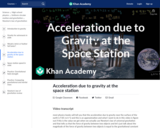
What is the acceleration due to gravity at the space station. Created by Sal Khan.
- Subject:
- Physical Science
- Physics
- Material Type:
- Lesson
- Provider:
- Khan Academy
- Provider Set:
- Khan Academy
- Author:
- Sal Khan
- Date Added:
- 07/02/2021

What is the acceleration due to gravity at the space station. Created by Sal Khan.
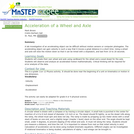
Students make a wheel and axle out of cardboard and a wooden dowel. It is rooled along a ramp made of parallel meter sticks, and the acceleration can be made small enough to make accurate measurements and calculations.

Students work as physicists to understand centripetal acceleration concepts. They also learn about a good robot design and the accelerometer sensor. They also learn about the relationship between centripetal acceleration and centripetal force governed by the radius between the motor and accelerometer and the amount of mass at the end of the robot's arm. Students graph and analyze data collected from an accelerometer, and learn to design robots with proper weight distribution across the robot for their robotic arms. Upon using a data logging program, they view their own data collected during the activity. By activity end , students understand how a change in radius or mass can affect the data obtained from the accelerometer through the plots generated from the data logging program. More specifically, students learn about the accuracy and precision of the accelerometer measurements from numerous trials.

This segment from Swift: Eyes through Time traces the history military officers and engineers discovering a strange phenomenon in the sky that astronomers now know are gamma-ray bursts.
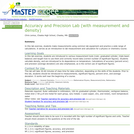
In this lab exercise, students practice correctly using measurement tools, recording data, calculating density, using significant figures, and exploring the concepts of accuracy and precision.
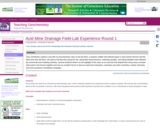
In this field-based exercise, students were given a tour of an abandoned mine site and asked to utilize a set of field measurements to describe the spatial details of metal transport. This drew on previous experience with field measurements and prompted them to work together to solve an observed chemical evolution of a contaminated brook. The exercise is an excellent example for students to bring together acid-base chemistry, redox chemistry, and thermodynamic concepts together to describe a reasonably complex system. The field component was completed in a full day, but we will be expanding this next fall for a 2 day exercise (weekend). The exercise was coupled with subsequent labs to complete analysis of the water samples and accomplish speciation calculations using PHREEQCI.
(Note: this resource was added to OER Commons as part of a batch upload of over 2,200 records. If you notice an issue with the quality of the metadata, please let us know by using the 'report' button and we will flag it for consideration.)
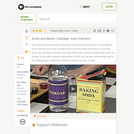
In this video segment, the ZOOM cast demonstrates how to use cabbage juice to find out if a solution is an acid or a base.

In this video segment adapted from ZOOM, two cast members demonstrate what happens when vinegar is added to baking soda inside a container. The resulting chemical reaction produces enough carbon dioxide to launch their paper rocket skyward.
Recommended for: Grades K-5
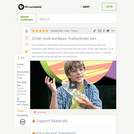
A car propelled by the reaction between lemon juice and baking soda has more in common with rockets and jet aircraft than one might think. In this video segment adapted from ZOOM, two cast members demonstrate the power of rocket-propelled vehicles and how to exploit the force produced by the carbon dioxide gas. Grades 3-8.
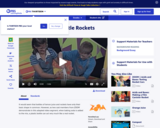
It would seem that bottles of lemon juice and rockets have only their basic shape in common. However, as two cast members from ZOOM demonstrate in this adapted video segment, when baking soda is added to the mix, a plastic bottle can act very much like a real rocket. Grades 3-8.
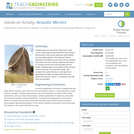
Students play and record the “Mary Had a Little Lamb” song using musical instruments and analyze the intensity of the sound using free audio editing and recording software. Then they use hollow Styrofoam half-spheres as acoustic mirrors (devices that reflect and focus sound), determine the radius of curvature of the mirror and calculate its focal length. Students place a microphone at the acoustic mirror focal point, re-record their songs, and compare the sound intensity on plot spectrums generated from their recordings both with and without the acoustic mirrors. A worksheet and KWL chart are provided.

This course will begin with brief overview of what important current research topics are in oceanography (physical, geological, and biological) and how acoustics can be used as a tool to address them. Three typical examples are climate, bottom geology, and marine mammal behavior. Will then address the acoustic inverse problem, reviewing inverse methods (linear and nonlinear) and the combination of acoustical methods with other measurements as an integrated system. Last part of course will concentrate on specific case studies, taken from current research journals. This course is taught on campus at MIT and with simultaneous video at Woods Hole Oceanographic Institution.
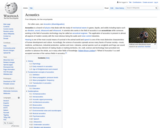
This title gives you a brief introduction on Acoustics for Undergraduate Level students. Its a part of an Assignment for OER Empowering Teachers.
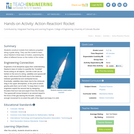
Students construct rockets from balloons propelled along a guide string. They use this model to learn about Newton's three laws of motion, examining the effect of different forces on the motion of the rocket.

By far most field trips in structural geology and regional tectonics do NOT take place in large urban centers with a trip focus on mitigation of hazards. What is described here is an example of the instructional and learning opportunities associated with active tectonic examination of large population centers.
ACTIVE TECTONICS, HAZARDS, ACTIVE TECTONICS AND SOCIETY, URBAN GEOLOGY, EARTHQUAKES
(Note: this resource was added to OER Commons as part of a batch upload of over 2,200 records. If you notice an issue with the quality of the metadata, please let us know by using the 'report' button and we will flag it for consideration.)
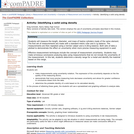
Effective measurement techniques include the concept of measurement uncertainty. Students may make erroneous conclusions analyzing data using measurements that do not include the uncertainty of the measurement. In this lab, students determine a density range for a metal and identify the material based on this range.
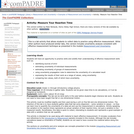
This is a lab activity that allows students to collect data to practice using effective measurement. While other authors have produced similar labs, this version includes uncertainty analysis consistent with effective measurement technique as presented in the module Measurement and Uncertainty.

The 16 lectures in this course cover the topics of adaptive antennas and phased arrays. Both theory and experiments are covered in the lectures. Part one (lectures 1 to 7) covers adaptive antennas. Part two (lectures 8 to 16) covers phased arrays. Parts one and two can be studied independently (in either order). The intended audience for this course is primarily practicing engineers and students in electrical engineering. This course is presented by Dr. Alan J. Fenn, senior staff member at MIT Lincoln Laboratory.
Online Publication

In this lab-based activity the students will use their knowledge about the law of conservation of energy to explain the loss of heat by warm water to cold water. Then, the students will use these concepts to design and carry an experiment to determine the unknown temperature of a hot water sample.
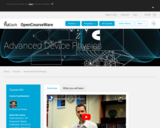
This course will focus for a large part on MOSFET and CMOS, but also on heterojunction BJT, and photonic devices.First non-ideal characteristics of MOSFETs will be discussed, like channel-length modulation and short-channel effects. We will also pay attention to threshold voltage modification by varying the dopant concentration. Further, MOS scaling will be discussed. A combination of an n-channel and p-channel MOSFET is used for CMOS devices that form the basis for current digital technology. The operation of a CMOS inverter will be explained. We will explain in more detail how the transfer characteristics relate to the CMOS design.